Summary
Three-spined sticklebacks (Gasterosteus aculeatus) showed a relative preference for a familiar prey size when hunting for two sizes of Daphnia magna in high density. This result is not compatible with the ‘apparent size’ hypothesis. Ten groups were investigated, each consisting of two stickle-backs tested under three consecutive experimental conditions, to establish whether the function of the preference for a familiar prey size could be avoidance of competition.
First, the relative competitive ability of each fish was determined by the proportion it consumed of three series of 60 medium-sized daphnia, offered pairwise. Second, during the consumption of five series of 30 pairs, each consisting of a large and a small daphnia, it was determined how many items each fish caught of each prey size. As handling times were equal for both prey types, the larger prey size was more profitable. There was a significant correlation between relative competitive ability and mean proportion of large daphnia in the diet. In the last series the less successful competitiors caught a higher proportion of small prey than in the first series. Finally, each fish was given the choice between large and small daphnia in the absence of its competitor. The sticklebacks chose a diet similar to the one they had been allowed to select previously with competition. The previously more successful competitors concentrated on large daphnia, whereas the poorer competitors fed as generalists but not unselectively.
The fish probably learned the distance from which they had recently attacked familiar prey successfully. This ‘sure attack’ distance depends on the fish's competitive ability.
Similar content being viewed by others
References
Barnard CJ, Brown CAJ (1981) Prey size selection and competition in the common shrew (Sorex araneus L.). Behav Ecol Sociobiol 8:239–243
Beukerna JJ (1968) Predation by the three-spined stickleback (Gasterosteus aculeatus L.): The influence of hunger and experience. Behaviour 31:1–126
Coates D (1980) Prey-size intake in humbug damselfish, Dascyllus aruanus (Pisces, Pomacentridae) living within social groups. J Anim Ecol 49:335–340
Curio E (1976) The ethology of predation. Springer, Berlin Heidelberg New York
Eggers DM (1982) Planktivore preference by prey size. Ecology 63:381–390
Gardner MB (1981) Mechanisms of size selectivity by planktivorous fish: A test of hypotheses. Ecology 62:571–578
Gibson RM (1980) Optimal prey size selection by three-spined sticklebacks (Gasteuosteus aculeatus): A test of the apparent size hypothesis. Z Tierpsychol 52:291–307
Godin JGJ (1978) Behavior of juvenile pink salmon (Oncorhynchus gorbuscha Walbaum) toward novel prey: Influence of ontogeny and experience. Environ Biol Fishes 3:261–266
Grossman MI, Greengard H, Ivy AC (1943) The effect of dietary composition on pancreatic enzymes. Am J Physiol 138:676–682
Janetos AC, Cole BJ (1981) Imperfectly optimal animals. Behav Ecol Sociobiol 9:203–209
Kacelnik A, Houston AI, Krebs JR (1981) Optimal foraging and territorial defence in the great tit (Parus major). Behav Ecol Sociobiol 8:35–40
Kislalioglu M, Gibson RN (1976) Prey “handling time” and its importance in food selection by the 15-spined stickle-back, Spinachia spinachia (L.). J Exp Mar Biol Ecol 25:151–158
Krebs JR (1973) Behavioral aspects of predation. In: Bateson PPG, Klopfer PH (eds) Perspectives in ethology. Plenum Press, New York London, pp 73–111
Krebs JR (1978) Optimal foraging: Decision rules for predatiors. In: Krebs JR, Davies NB (eds) Behavioural ecology: An evolutionary approach. Blackwell, Oxford, pp 23–63
Krebs JR (1980) Optimal foraging, predation risk and territory defense. Ardea 68:83–90
MacArthur RH, Pianka ER (1966) On optimal use of a patchy environment. Am Nat 100:603–609
Milinski M (1977) Do all members of a swarm suffer the same predation? Z Tierpsychol 45:373–388
Milinski M, Heller R (1978) Influence of a predator on the optimal foraging behaviour of sticklebacks (Gasterosteus aculeatus L.). Nature 275:642–644
Milinski M, Löwenstein C (1980) On predator selection against abnormalities of movement. A test of a hypothesis. Z Tierpsychol 53:325–340
O'Brien WJ (1979) The predator-prey interaction of planktivorous fish and zooplankton. Am Sci 67:573–581
O'Brien WJ, Slade NA, Vinyard GL (1976) Apparent size as the determinant of prey selection by bluegill sunfish (Lepomis macrochirus). Ecology 57:1304–1310
Partridge L (1981) Increased preferences for familiar foods in small mammals. Anim Behav 29:211–216
Rubenstein DI (1981) Individual variation and competition in the everglades pygmy sunfish. J Anim Ecol 50:337–350
Sachs L (1978) Angewandte Statistik. Springer, Berlin Heidelberg New York
Sih A (1980) Optimal behavior: Can foragers balance two conflicting demands? Science 210:1041–1043
Sokal RR, Rohlf FJ (1969) Biometry. Freeman, San Francisco
Vinyard GL (1980) Differential prey vulnerability and predator selectivity: Effects of evasive prey on bluegill (Lepomis macrochirus) and pumkinseed (L. gibbosus) predation. Can J Fish Aquat Sci 37:2294–2299
Ware DM (1971) Predation by rainbow trout (Salmo gairdneri): The effect of experience. J Fish Res Board Can 28:1847–1852
Zach R, Smith JNM (1981) Optimal foraging in wild birds? In: Kamil AC, Sargent TD (eds) Foraging behavior. Garland STPM Press, New York London, pp 95–109
Author information
Authors and Affiliations
Rights and permissions
About this article
Cite this article
Milinski, M. Optimal foraging: The influence of intraspecific competition on diet selection. Behav Ecol Sociobiol 11, 109–115 (1982). https://doi.org/10.1007/BF00300099
Received:
Accepted:
Issue Date:
DOI: https://doi.org/10.1007/BF00300099




